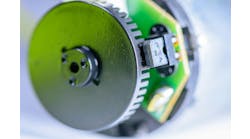A common discussion about encoders revolves around specifications. How may pulses per revolution? What type of output? Incremental or absolute? These questions must be answered; however, there are often many considerations when deciding to use them on a machine. These devices must work to get better control of a machine position, but they must also work well in the control system.
An encoder’s purpose is to report the position of linear or rotary motion as a digital signal to a controller, which then uses it for monitoring and control purposes in a variety of machine tools, multi-axis positioning systems and robotics. With a little math programming or built-in controller functionality, this digitally translated position can be used to monitor velocity, distance, angle, acceleration, deceleration and direction.
If the control system needs more information than “motor on” or other open-loop status information, a sensor of some type is required. A motor gearbox output shaft can be monitored with a high-speed proximity switch or Hall-effect sensor. This is typically a tachometer configuration where one pulse per motor revolution or teeth of a gear is converted to rpm, but this speed information is very coarse. Some drives can also monitor the motor current or pulse-width modulation (PWM) output and assume rotation causing torque in the motor, but signal errors and noise can cause inaccuracies. For a more accurate and reliable closed-loop feedback signal, encoders are a best practice.
There are many reasons to use incremental or absolute encoders, and quadrature or nonquadrature outputs. In its basic form, an incremental encoder provides digital pulse signals suitable for use with high-speed PLC inputs or counter modules.
Incremental encoders require a special PLC input to properly capture the signal. In addition to an encoder's mechanical speed limit and the type of output the encoder produces, a key specification is the encoder's response frequency—the maximum frequency the encoder signals can change and still provide an accurate output. This defines both maximum encoder electrical speed and the PLC input module’s required maximum switching frequency. A standard PLC input module likely will not work.
For example, an encoder with 2,048 pulses per revolution (ppr) spinning at 5,000 rpm creates a signal frequency of more than 170 kHz (2,048 ppr x 5,000 rpm / 60 sec/min). Many encoders' response frequencies and high-speed PLC inputs are below this frequency, which, depending on the device, can be between 100 kHz and 250 kHz. While most applications run at slower speeds, be sure to check the frequency required.
A simple absolute encoder can provide parallel, discrete output signals, often in a Gray code format, that can be monitored by a PLC's standard dc inputs. No homing routine is required for the encoder to know position. With 10-digital input bits, Gray code provides a resolution of 1,024 pulses per revolution; that is plenty of information for a controller to use to monitor and control position in many applications.
However, the response frequency of the encoder still applies, but the PLC scan time must be considered, as well. With a PLC running at a 10 ms/scan rate, the digital inputs are only updated (read) about 100 times a second. That sounds fast unless an absolute encoder with 1,024 pulses per revolution is updating input signals. Rotating at just 6 rpm, the encoder changes states more than 102 times a second. Do you need all the data, or can some be lost?
If data cannot be lost, adding motion controllers or connecting encoders directly to drives is the next step for higher resolution and higher frequency applications.
With the advent of the Industrial Internet of Things (IIoT) and related smart devices, encoders are moving beyond the basic incremental encoder pulse and direction and parallel absolute position encoders. They are connecting to serial, fieldbus and Ethernet networks; and some are becoming programmable.
The synchronous serial interface (SSI), based on the RS-422 standard, has been around for quite a while and can connect directly to a PLC with the proper digital interface module. Moving to a fieldbus, such as Profibus, CANopen and DeviceNet, the bus topology is easy to integrate into automation, especially if there are many devices.
Using an Industrial Ethernet interface to encoders is also a great option, especially since many controllers are already using EtherNet/IP, Profinet, Powerlink, EtherCAT and others Ethernet protocols.
Both fieldbus and Ethernet communication interfaces provide a simple way to read position data from an encoder, but they are also smarter and provide extensive diagnostic capabilities.
With any of these communication options, be sure to understand the update rate of the encoder and the update rate required by the application. Monitoring and controlling positions of an on-the-fly cutter process has much higher speed and resolution requirements than controlling the speed of several conveyors.
For an encoder there are several parameters that must be specified. The programmable encoders are making that configurable. Once an incremental or absolute programmable encoder is selected, resolution can be programmed. Some programmable encoders may include programmable output types, index pulses, number of turns and waveforms. Some programmable absolute encoders also allow configuration of the code, such as Gray or binary, and code sequence, such as clockwise.
Be sure to understand all encoder requirements for an application, double-check some key specifications, such as frequency, and consider a variety of ways to connect it to the controller.






